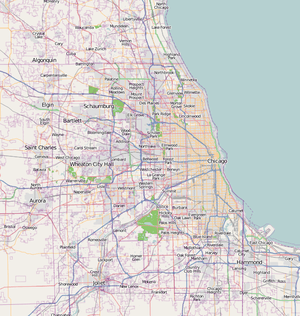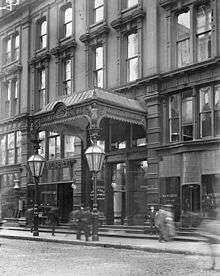The Palmer House Hilton
The Palmer House Hilton is a historic hotel in Chicago in the city's Loop area. Currently operating as the Palmer House - A Hilton Hotel, it is a Historic Hotels of America member,[1] the official program of the National Trust for Historic Preservation. The Palmer House was the city's first hotel with elevators and the first hotel with electric light bulbs and telephones in the guest rooms. It has also been dubbed the longest continuously operating hotel in North America.
| Palmer House Hotel | |
|---|---|
.jpg) The Palmer House Hotel | |
| Location | 17 East Monroe Street Chicago, Illinois |
| Coordinates | 41.880344°N 87.626910°W |
| Built | 1875 |
| Rebuilt | 1923-1925 |
| Architect | John M. Van Osdel (2nd) Holabird & Roche (current) |
Chicago Landmark | |
| Designated | December 13, 2006 |
 Location of Palmer House Hotel in Chicago metropolitan area | |
History

Three Palmer House hotels have been located at the corner of State and Monroe streets in Chicago.
First Palmer House

The first (known as "The Palmer") was built as a wedding present from Potter Palmer to his bride Bertha Honoré. It opened on September 26, 1871, but burned down just 13 days later on October 9, 1871 in the Great Chicago Fire. Palmer immediately set to work rebuilding, and with a $1.7 million signature loan (believed to be the largest individual loan ever secured at that time), constructed one of the fanciest hotels worldwide in postfire Chicago.

Second Palmer House

Designed by architect John M. Van Osdel, the second Palmer House Hotel was seven stories. Its amenities included oversized rooms, luxurious decor, and sumptuous meals served in grand style. The floor of its barber shop was tiled and silver dollars were embedded in a diamond pattern. Constructed mainly of iron and brick, the hotel was widely advertised as, "The World's Only Fire Proof Hotel."[2] Famous visitors included presidential hopefuls James Garfield, Grover Cleveland, Ulysses S. Grant, William Jennings Bryan, and William McKinley; writers Mark Twain, L. Frank Baum, and Oscar Wilde; actresses Sarah Bernhardt and Eleonora Duse, and French cabaret singer Yvette Guilbert in 1897. It was completed in 1875. An 1895 meeting at the hotel of faculty representatives from various Midwestern universities resulted in the founding of the Big Ten Conference.
Third Palmer House

By the 1920s, the business in downtown Chicago could support a much larger facility, and the Palmer Estate decided to erect a new 25-story hotel. They hired Holabird & Roche to design the building, and their team included architect Richard Neutra in a junior role. Between 1923 and 1925, the hotel was rebuilt on the same site.[3]
In December 1945, Conrad Hilton bought the Palmer House for $20 million and it was thereafter known as The Palmer House Hilton. In 2005, Hilton sold the property to Thor Equities, but it remains part of the Hilton chain.[4]
The architecture firms of Loebl Schlossman & Hackl and David Fleener Architects completely renovated and restored the hotel between 2007 and 2009.[5] The total cost was over $170 million.[6] The hotel has a total of 1,639 guest rooms, making it the second-largest hotel in the city after the Hyatt Regency Chicago.[7] It has recently had its name adjusted to Palmer House - A Hilton Hotel.
In 1970, the hotel was the site of the murder of Evelyn Okubo, a young Japanese-American racial justice activist attending a Japanese American Citizens League convention held there.[8]
Chicago's Frankie Laine sang there in '63, bluesman Josh White performed there in '66, Tony Bennett sang there for several nights in '68, Trini Lopez sang there in '73, and the male pop vocal trio The Lettermen sang there in '73.
See also
Chocolate brownie, invented at the hotel.
References
- Historic Hotel of America
- Susan Bard Hall. "The Palmer House". Away.com Historic Traveller. Primedia Publications. Archived from the original on 2007-02-02. Retrieved 2007-06-21.
It opened as The Palmer, at the northwest corner of State and Quincy streets, with 225 rooms on September 26, 1871. Thirteen days later, it burned in the Great Chicago Fire.
- Berger, Molly W. "Hotels" at the Encyclopedia of Chicago
- "Thor Buys Hilton's Palmer House". Los Angeles Times. Bloomberg News. August 17, 2005. Retrieved 2017-10-06.
Thor Equities ...said it had bought the Palmer House Hilton...
- Weiner, Michael A. (Nov–Dec 2007). "Palmer House Hilton in process of restoring aging infrastructure". Hospitality Construction. 2 (6): 38. Retrieved 25 July 2014.
- Bernstein, Fred A. (October 25, 2008). "A Hotel Looks Back to Its 1920s Glamour". The New York Times. Retrieved October 7, 2017.
- "Chicago's Largest Hotels" (PDF). Crain's Chicago Business. December 31, 2006.
- Harden, Jacelyn (2003). Double Cross: Japanese Americans in Black and White Chicago. Minneapolis: University of Minnesota Press. p. 128. ISBN 9781452905969. Retrieved 2017-09-13.
Further reading
- Robert V. Allegrini, Chicago's Grand Hotels: The Palmer House Hilton, The Drake, and The Hilton Chicago (ISBN 0738539546)
External links
| Wikimedia Commons has media related to Palmer House Hilton. |
- Palmer House - official website
- Palmer House on Facebook
- Palmer House - A Hilton Hotel - official Hilton website with virtual tour
- Palmer House Chicagology Palmer House history by Chicagology
- Chicago Historical Society - 1873 description by Rudyard Kipling following the Great Chicago Fire
- Fred A. Bernstein, "A Hotel Looks Back to Its 1920s Glamour", The New York Times, October 25, 2008
- Palmer House Hilton Reviews - Reviews of guests who have visited the hotel